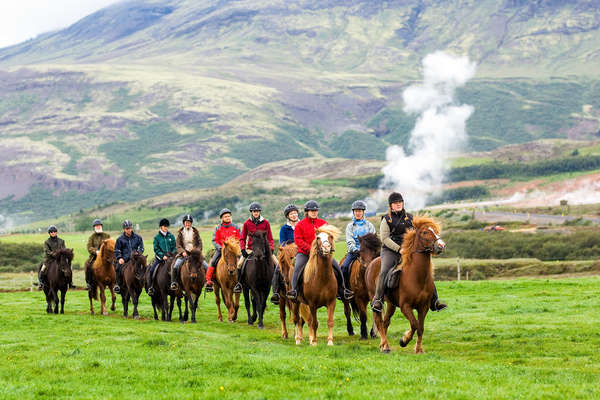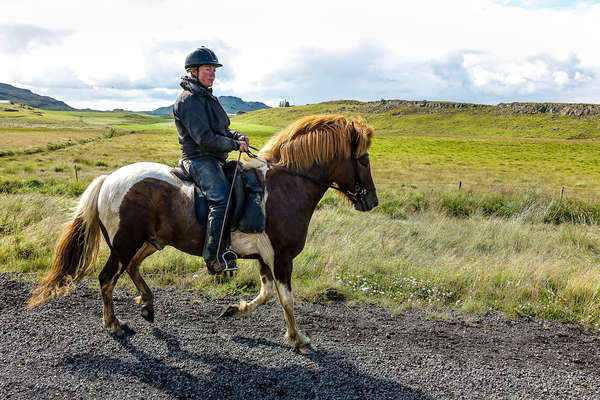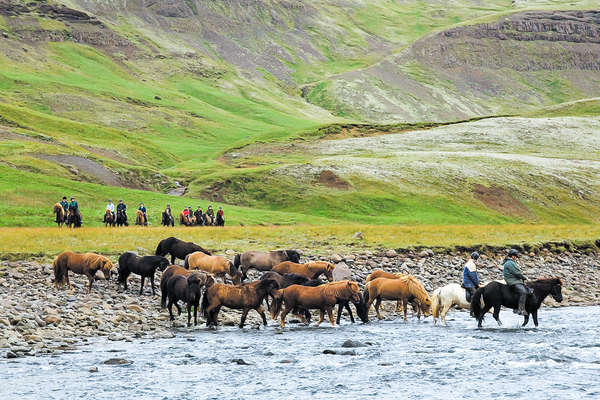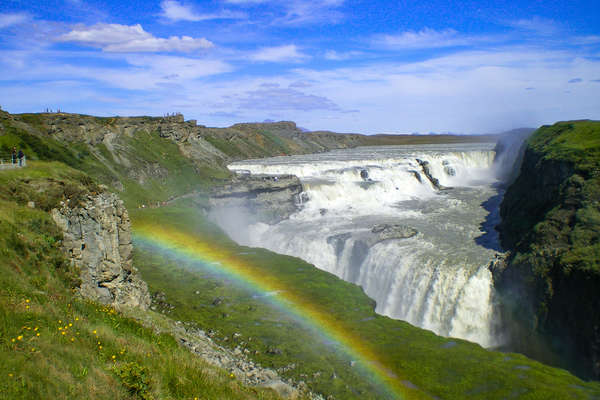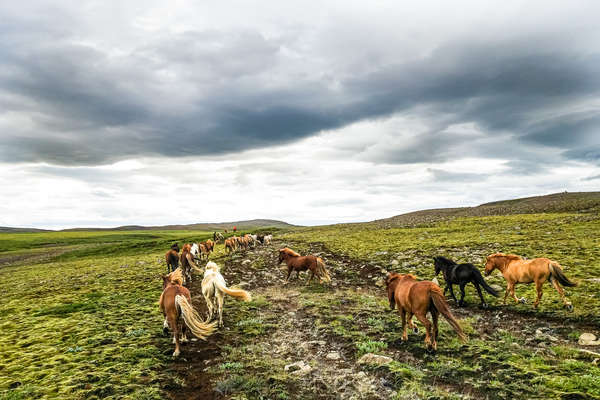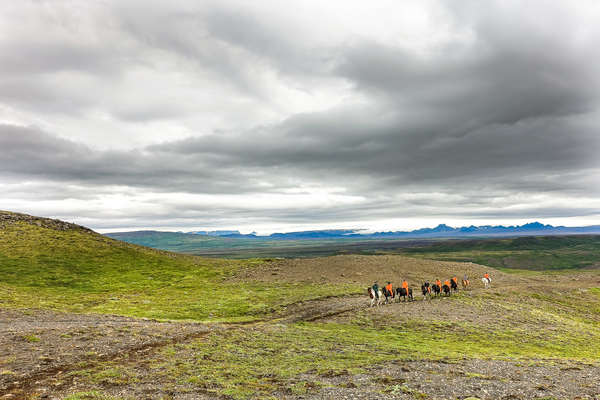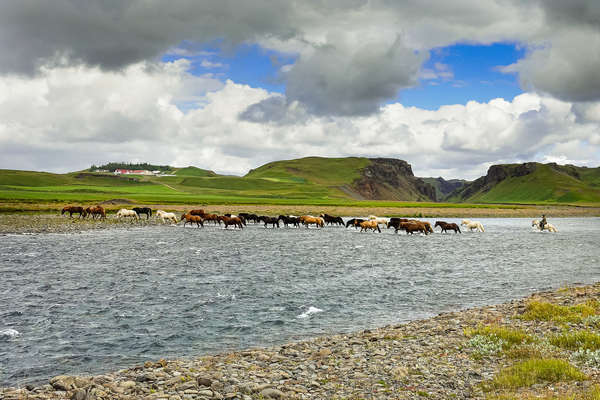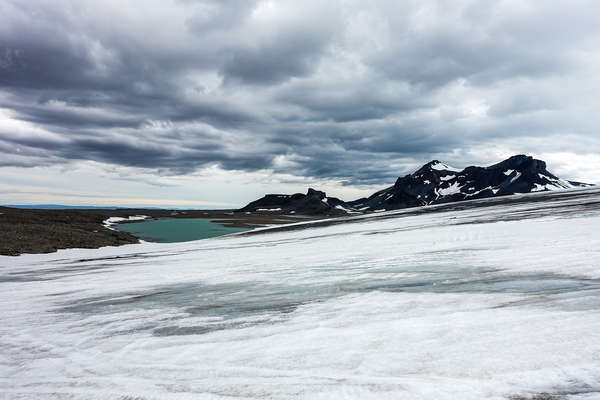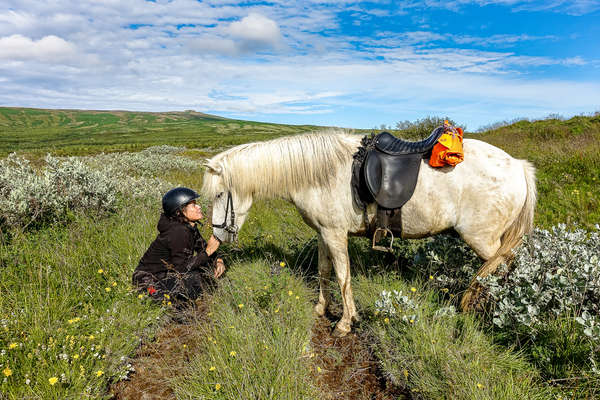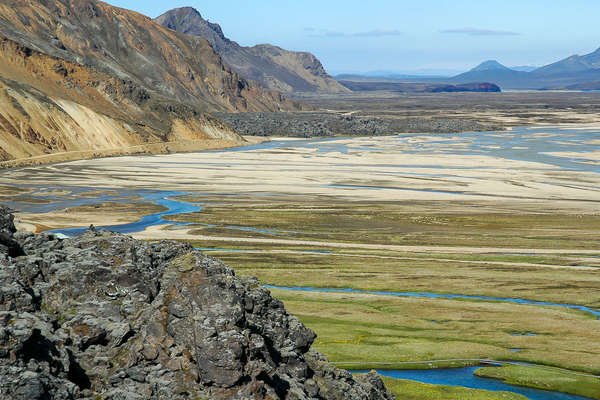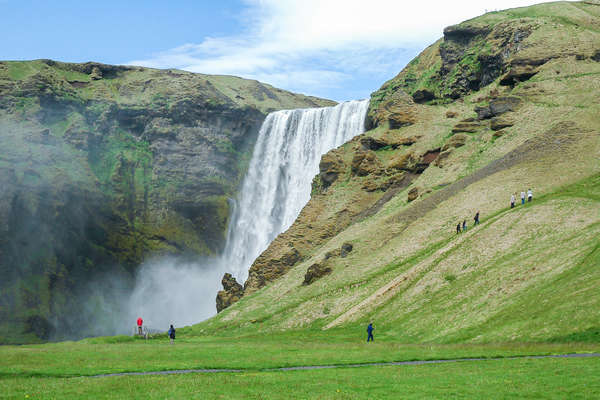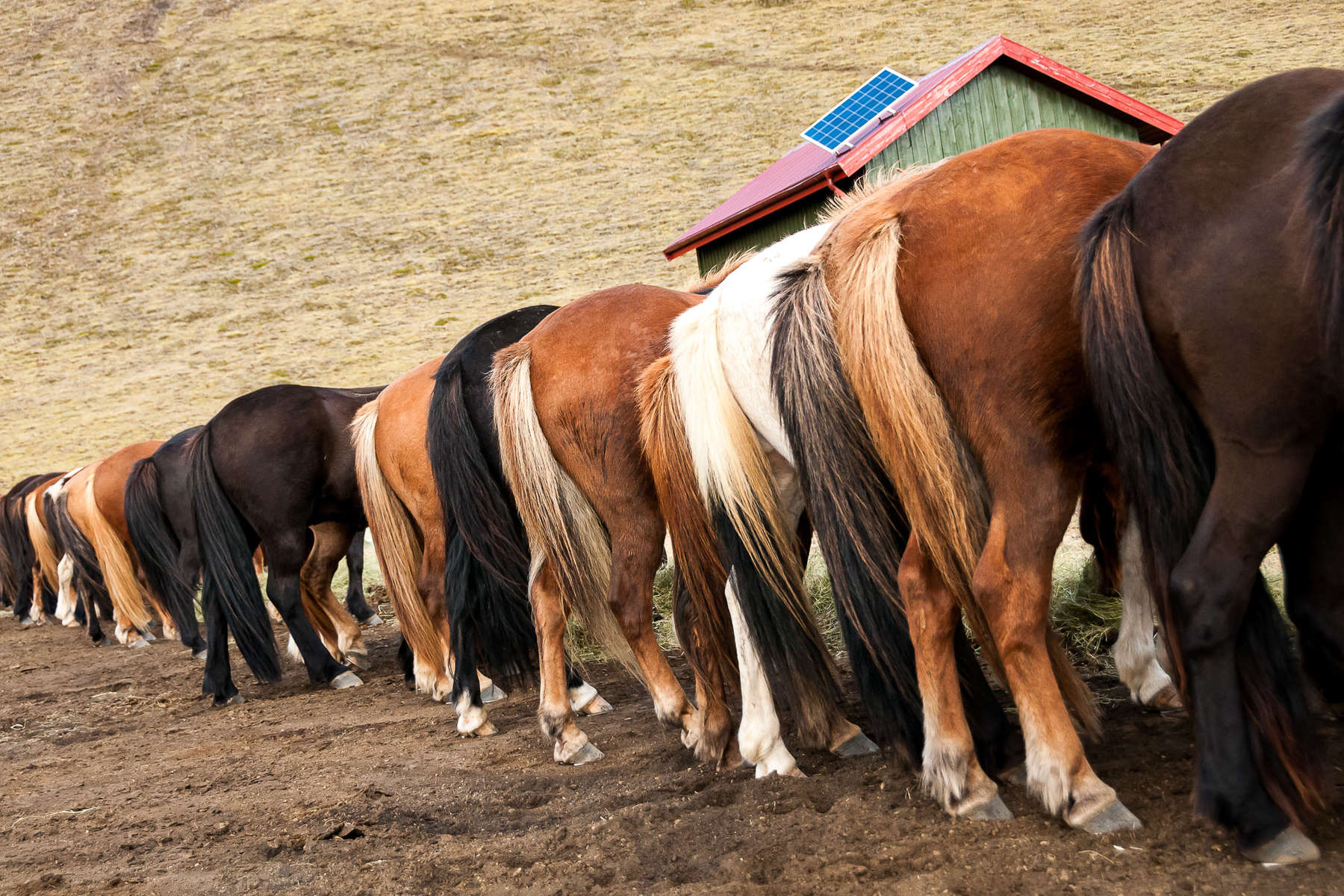
from 8 y.o
From the horse’s mouth
Itinerary
Highlights
- Discover Iceland's famous Golden Circle - Gullfoss waterfall and the hot springs at Geysir.
- Enjoy a ride that's accessible to all riders from 12 years and upwards. The pacing and terrain is well-suited to young riders
- Experience the brisk and freeing tölt, a pace unique to the small and energetic Icelandic horses
- Unwind in the Secret Lagoon's thermal baths after a good day spent in the saddle
- Part of this tour can be booked as a 5-day tour (4 riding days), or as a 2-day tour (2 riding days)
Dates & prices
Price details
- Rates are per person, based on sharing two or four-bedded rooms. There is no single supplement for the riding days as you should be prepared to share.
- Groups are made up of a maximum of 20 international riders and an English speaking guide. All departures are confirmed regardless of the number of riders on the tour.
- Transfers to and from Reykjavik airport are not included in the price for the trip. See here for more info on how to get from the airport to the city centre.
- The last night in Reykjavik is not included in the cost of your holiday. Please contact us and we will recommend a good hotel in downtown Reykjavik.
- Vegan and/or Gluten Free diets will incur on an extra supplement of around £90/€100/$110 per person.
- Children from 8 years of age can be accommodated provided they are good riders, with parental consent and a good riding level
- Discounts are available for families of 3+ (two parents and one child aged 12+), and for children between the age of 9 and 12. Please contact us.
- Rider weight limit is 110kg / 17,3 st / 242lb
Please Note
The itinerary may be modified at anytime for security reasons, meteorological or events beyond our control such as blocked roads, rivers in flood, drought, strikes and local holidays. Equus Journeys, our local partners and their local guides will always strive to find the best solution and will alter the itinerary as needed.
The names of the hotels and accommodation are given for information only and depending on availability, they may be modified without notice and replaced by another of a similar standard.
Price includes
Support team
2 - 4 poeple in charge of the free running herd
English speaking tour leader from your arrival in Reykjavik
Logistics
1 support vehicle and driver
2-3 horses equipped with saddle and bridle per rider
Accommodation
Sleeping bags and liners are provided
Meals
Extras
Entrance fee for Secret Lagoon on day 6
Price doesn't include
Meals
Beverages and personal extras
Special diet supplement - please see above
Accommodation
Transport
International flights
Extra
Insurance
Optional
Extras
All additional excursions, activities and expeditions. Including the possibility of snowmobiling on the Langjökull glacier on day 5 (approx. £110)
Equestrian info
Horses
Guide & local team
Minimum riding ability
Minimum riding ability
Rider weight limit is 110kg/17,3 st/242lb
Pace
Tacking ability and participation
Trip conditions and Requested experience
Experience of riding a trail over several days would be an advantage but is not essential. Riders who do not ride regularly would need to get back into the saddle before joining this ride.
Equestrian equipment
Hard hats are mandatory. We recommend our riders to wear a helmet to the correct standard and you should bring your own to ensure a proper fit.
You will be provided with a raincoat but should still bring your own warm coat to wear underneath.
Travel info
Comfort
There are double to quadruple rooms available. Toilets and showers are available.
While phone coverage at the farm can be limited, Wifi is usually available.
Please understand that accommodation in Iceland is usually basic, with little privacy, small rooms and limited showers.
Meals
Vegetarian diets can be accommodated with advance notice. Vegan and Gluten free diets can be accommodated at an extra cost.
Alcoholic beverages are not included in the tour price and are hard to get in the highlands. They can be bought at a reasonable price in the Duty Free Store at Keflavik Airport upon arrival.
Climate
Tips
Packing list
There are some important packing considerations for a riding holiday in Iceland. The Icelandic horses have had no contact with other equine species and are not vaccinated. They do not have any resistance to diseases which are common elsewhere in the world and so it is important to take precautions to prevent the spread of infections.
- You should NOT take the following products into Iceland: saddles, bridles, halters, saddle pads, whips, brushes or any leather products which have been in contact with a horse.
- Your riding clothes must be thoroughly cleaned at least 5 days before departure (riding breeches, jumpers, coats, gloves) and should be washed in temperatures of at least 40c.
- Items which cannot be washed at 40c, such as riding hats or leather boots must be thoroughly disinfected at least five days before departure:
1. Wash in detergent.
2. Dry thoroughly
3. Spray with a 1% solution of Virkon detergent (10g per litre of water)
Please visit the Icelandic veterinary authority website to learn more.
--
Please pack carefully and sensibly: the following guide is here to give you an idea of what to bring. If possible, please opt for a soft bag instead of hard shell suitcase.
Head
- A riding helmet is compulsory and we recommend that you take your own to ensure a correct fit.
- A flyhat to wear over your helmet may be a good idea in the summer months, when flies can be be an issue
- Sunhat for when not riding
- Sunglasses - with a cord attached so they don't fly off when riding
- Buff or bandana for protecting your neck and face from the elements
- Warm hat for cold evenings/days
Upper body
- Thermals in case of cold weather
- Long sleeved shirts provide protection from the sun or extra warmth
- Down jacket or gilet for cold evenings
- T-shirts
- Lightweight fleece or jumper
- Warm polar fleece or equivalent
- Waterproof jacket
Legs
- Lightweight, comfortable riding trousers or jodhpurs - we recommend riding in them at home before taking them on holiday to ensure they don't rub.
- Waterproof over trousers
- Casual clothes for the evenings (jeans or walking trousers)
- Thermal trousers
Hands and Feet
- Comfortable riding boots. We recommend short boots with half chaps but you may wish to take long chaps. We don't recommend taking your favourite long leather boots in case they get damaged. It is recommended your boots are waterproof as you may be crossing rivers and they can get wet.
- Sandals/flip-flops
- Several pairs of warm socks
- Gloves
Nightwear
- Slippers (you will have to remove your shoes inside the accommodation)
- Eye mask
Other useful items
- A fly net against bugs
- Swimsuit
- Bumbag for carrying your camera and small items whilst riding
- Wet Wipes or equivalent (for when washing facilities aren't available)
- Ear plugs (for light sleepers)
Medical kit
- Sunscreen and lip balm - should be high factor
- Insect repellent
- Any medication you regularly take
- Blister plasters in case of any rubs
- Antiseptic cream, plasters, aspirin, anti-histamine, insect-bite salve etc...
- Spare prescription glasses/contact lenses
- Eye drops
- Imodium or similar anti-diarrhoea medication
- Re-hydration sachets
- Antiseptic wipes
- Handwash gel
Our Recommendations
- Backpacks cannot be worn whilst riding. We recommend a small bumbag or a coat with pockets so that you can carry small items with you during the day.
- We recommend travelling in your riding boots and carrying your hat and some riding clothes in your hand luggage - then if your luggage goes astray you are still able to ride!
- Carry a copy of your passport and insurance documentation with you.
Sustainable tourism
- Travel light. It's a little known fact, but the lighter you pack, the better for the environment as heavy bags will produce higher emissions (when flying a plane or driving a car!).
- Reduce plastic waste. Take your favorite reusable bottle with you. Avoid single-use bags, cups, or straws.
- Preserve nature. Always take your rubbish with you during the ride and recycle them. Leave all the flowers or plants as you found them, and never get too close when observing wildlife. Make sure to use eco-friendly products such as body wash or laundry detergent (if camping) to protect both your skin and the environment.
- Choose your experiences carefully. Respect animal life by not participating in any activities that abuse wild animals (shows, elephant rides, etc.).
- Support local populations. Buy local handicrafts, be respectful of customs, and learn about the culture of local communities.
- Share! Raise awareness among your family and friends about sustainable tourism.
Did you know?
Did you know?
This tour was
nominated by CNNgo as one of the greatest horseback vacations in the world, and
we can see why! Is there a better way to see all the sights of the Golden
Circle than on horseback? Highlights of this riding holiday including many of
the Golden Circle’s best known attractions, such as:
-
Geysir Hot Springs – a geothermal area located north
of the southern lowlands, at an altitude of 105-120 m above sea level.
-
Gullfoss waterfall (the “Golden Falls”) – one of
Iceland’s most iconic waterfalls, made a nature reserve in 1979. It gets its
name from the golden hues of its glacial waters, although others argue that it
was named after the rainbow that can be seen when the sun shines and hits the
abundant mist produced by the waterfall.
-
The Secret Lagoon: The Secret Lagoon is a
man-made hot spring located in the geothermal area of Hverahólmi. Towards the
end of your riding holiday, you will have the chance to swim in its hot waters,
maintained at a constant temperature of 38/40 °C.

